The Romantic Manifesto: A Philosophy of Literature Read online
Page 5
In this connection, I should like to relate, without comment, a personal incident. At the age of 16, for one summer, I joined a drawing class given by a man who would have become a great artist had he survived, which I doubt (this was in Russia); his paintings were magnificent, even then. He forbade the class ever to draw a curved line: he taught us that every curve must be broken into facets of intersecting straight lines. I fell in love with this style; I still am. Today, I know the reason fully. What I felt then (and still do) was not: “This is for me,” but: “This is me.”
Compared to painting, sculpture is more limited a form of art. It expresses an artist’s view of existence through his treatment of the human figure, but it is confined to the human figure. (For a discussion of sculpture’s means, I will refer you to “Metaphysics in Marble” by Mary Ann Sures, The Objectivist, February- March 1969.)
Dealing with two senses, sight and touch, sculpture is restricted by the necessity to present a three-dimensional shape as man does not perceive it: without color. Visually, sculpture offers shape as an abstraction; but touch is a somewhat concrete-bound sense and confines sculpture to concrete entities. Of these, only the figure of man can project a metaphysical meaning. There is little that one can express in the statue of an animal or of an inanimate object.
Psycho-epistemologically, it is the requirements of the sense of touch that make the texture of a human body a crucial element in sculpture, and virtually a hallmark of great sculptors. Observe the manner in which the softness, the smoothness, the pliant resiliency of the skin is conveyed by rigid marble in such statues as the Venus de Milo or Michelangelo’s Pietà.
It is worth noting that sculpture is almost a dead art. Its great day was in Ancient Greece which, philosophically, was a man-centered civilization. A Renaissance is always possible, but the future of sculpture depends to a large extent on the future of architecture. The two arts are closely allied; one of the problems of sculpture lies in the fact that one of its most effective functions is to serve as architectural ornament.
I shall not include architecture in this discussion—I assume the reader knows which book I will refer him to.
This brings us to the subject of music.
The fundamental difference between music and the other arts lies in the fact that music is experienced as if it reversed man’s normal psycho-epistemological process.
The other arts create a physical object (i.e., an object perceived by man’s senses, be it a book or a painting) and the psycho-epistemological process goes from the perception of the object to the conceptual grasp of its meaning, to an appraisal in terms of one’s basic values, to a consequent emotion. The pattern is: from perception—to conceptual understanding—to appraisal—to emotion.
The pattern of the process involved in music is: from perception—to emotion—to appraisal—to conceptual understanding.
Music is experienced as if it had the power to reach man’s emotions directly.
As in the case of all emotions, existential or esthetic, the psycho-epistemological processes involved in the response to music are automatized and are experienced as a single, instantaneous reaction, faster than one can identify its components.
It is possible to observe introspectively (up to a certain point) what one’s mind does while listening to music: it evokes subconscious material—images, actions, scenes, actual or imaginary experiences—that seems to flow haphazardly, without direction, in brief, random snatches, merging, changing and vanishing, like the progression of a dream. But, in fact, this flow is selective and consistent: the emotional meaning of the subconscious material corresponds to the emotions projected by the music.
Subconsciously (i.e., implicitly), man knows that he cannot experience an actually causeless and objectless emotion. When music induces an emotional state without external object, his subconscious suggests an internal one. The process is wordless, directed, in effect, by the equivalent of the words: “I would feel this way if…” if I were in a beautiful garden on a spring morning… if I were dancing in a great, brilliant ballroom… if I were seeing the person I love… “I would feel this way if…” if I were fighting a violent storm at sea… if I were climbing up the crumbling side of a mountain… if I were on the barricades… “I would feel this way if…” if I reached the top of that mountain… if I stood in full sunlight… if I leaped over that barrier, as I did today… as I will tomorrow…
Observe three aspects of this phenomenon: (1) It is induced by deliberately suspending one’s conscious thoughts and surrendering to the guidance of one’s emotions. (2) The subconscious material has to flow because no single image can capture the meaning of the musical experience, the mind needs a succession of images, it is groping for that which they have in common, i.e., for an emotional abstraction. (3) The process of emotional abstraction—i.e., the process of classifying things according to the emotions they evoke—is the process by which one formed one’s sense of life.
A sense of life is a preconceptual equivalent of metaphysics, an emotional, subconsciously integrated appraisal of man and of existence. It is in terms of his fundamental emotions—i.e., the emotions produced by his own metaphysical value-judgments—that man responds to music.
Music cannot tell a story, it cannot deal with concretes, it cannot convey a specific existential phenomenon, such as a peaceful countryside or a stormy sea. The theme of a composition entitled “Spring Song” is not spring, but the emotions which spring evoked in the composer. Even concepts which, intellectually, belong to a complex level of abstraction, such as “peace,” “revolution,” “religion,” are too specific, too concrete to be expressed in music. All that music can do with such themes is convey the emotions of serenity, or defiance, or exaltation. Liszt’s “St. Francis Walking on the Waters” was inspired by a specific legend, but what it conveys is a passionately dedicated struggle and triumph—by whom and in the name of what, is for each individual listener to supply.
Music communicates emotions, which one grasps, but does not actually feel; what one feels is a suggestion, a kind of distant, dissociated, depersonalized emotion—until and unless it unites with one’s own sense of life. But since the music’s emotional content is not communicated conceptually or evoked existentially, one does feel it in some peculiar, subterranean way.
Music conveys the same categories of emotions to listeners who hold widely divergent views of life. As a rule, men agree on whether a given piece of music is gay or sad or violent or solemn. But even though, in a generalized way, they experience the same emotions in response to the same music, there are radical differences in how they appraise this experience—i.e., how they feel about these feelings.
On a number of occasions, I made the following experiment: I asked a group of guests to listen to a recorded piece of music, then describe what image, action or event it evoked in their minds spontaneously and inspirationally, without conscious devising or thought (it was a kind of auditory Thematic Apperception Test). The resulting descriptions varied in concrete details, in clarity, in imaginative color, but all had grasped the same basic emotion—with eloquent differences of appraisal. For example, there was a continuum of mixed responses between two pure extremes which, condensed, were: “I felt exalted because this music is so light-heartedly happy,” and: “I felt irritated because this music is so light-heartedly happy and, therefore, superficial.”
Psycho-epistemologically, the pattern of the response to music seems to be as follows: one perceives the music, one grasps the suggestion of a certain emotional state and, with one’s sense of life serving as the criterion, one appraises this state as enjoyable or painful, desirable or undesirable, significant or negligible, according to whether it corresponds to or contradicts one’s fundamental feeling about life.
When the emotional abstraction projected by the music corresponds to one’s sense of life, the abstraction acquires a full, bright, almost violent reality—and one feels, at times, an emotion of greater intensity than any exper
ienced existentially. When the emotional abstraction projected by the music is irrelevant to or contradicts one’s sense of life, one feels nothing except a dim uneasiness or resentment or a special kind of enervating boredom.
As corroborating evidence: I have observed a number of cases involving persons who, over a period of time, underwent a significant change in their fundamental view of life (some, in the direction of improvement; others, of deterioration). Their musical preferences changed accordingly; the change was gradual, automatic and subconscious, without any decision or conscious intention on their part.
It must be stressed that the pattern is not so gross and simple as preferring gay music to sad music or vice versa, according to a “benevolent” or “malevolent” view of the universe. The issue is much more complex and much more specifically musical than that: it is not merely what particular emotion a given composition conveys, but how it conveys it, by what musical means or method. (For instance, I like operetta music of a certain kind, but I would take a funeral march in preference to “The Blue Danube Waltz” or to the Nelson Eddy-Jeanette Mac-Donald kind of music.)
As in the case of any other art or any human product, the historical development of music followed the development of philosophy. But the differences in the music produced by various cultures in the various eras of history are deeper than those among the other arts (even the sounds used and the scales are different). Western man can understand and enjoy Oriental painting; but Oriental music is unintelligible to him, it evokes nothing, it sounds like noise. In this respect, the differences in the music of various cultures resemble the differences in language; a given language is unintelligible to foreigners. But language expresses concepts, and different languages can be translated into one another; different kinds of music cannot. There is no common vocabulary of music (not even among the individual members of the same culture). Music communicates emotions—and it is highly doubtful whether the music of different cultures communicates the same emotions. Man’s emotional capacity as such is universal, but the actual experience of particular emotions is not: the experience of certain sense-of-life emotions precludes the experience of certain others.
This brings us to the great, unanswered question: Why does music make us experience emotions?
In the other arts, whose works are perceived by the normal cognitive process, the answer can be found in the work itself by a conceptual analysis of its nature and meaning; a common vocabulary and an objective criterion of esthetic judgment can be established. There is no such vocabulary or criterion, at present, in the field of music—neither among different cultures nor within the same culture.
It is obvious that the answer lies in the nature of the work, since it is the work that evokes the emotions. But how does it do it? Why does a succession of sounds produce an emotional reaction? Why does it involve man’s deepest emotions and his crucial, metaphysical values? How can sounds reach man’s emotions directly, in a manner that seems to by-pass his intellect? What does a certain combination of sounds do to man’s consciousness to make him identify it as gay or sad?
No one has yet discovered the answers and, I hasten to add, neither have I. The formulation of a common vocabulary of music would require these answers. It would require: a translation of the musical experience, the inner experience, into conceptual terms; an explanation of why certain sounds strike us a certain way; a definition of the axioms of musical perception, from which the appropriate esthetic principles could be derived, which would serve as a base for the objective validation of esthetic judgments.
This means that we need a clear, conceptual distinction and separation of object from subject in the field of musical perception, such as we do possess in the other arts and in the wider field of our cognitive faculty. Conceptual cognition necessitates this separation: until a man is able to distinguish his inner processes from the facts which he perceives, he remains on the perceptual level of awareness. An animal cannot grasp such a distinction; neither can a very young child. Man has grasped it in regard to his other senses and his other arts; he can tell whether a blurring of his vision is produced by a thick fog or by his failing eyesight. It is only in the field of specifically musical perception that man is still in a state of early infancy.
In listening to music, a man cannot tell clearly, neither to himself nor to others—and, therefore, cannot prove—which aspects of his experience are inherent in the music and which are contributed by his own consciousness. He experiences it as an indivisible whole, he feels as if the magnificent exaltation were there, in the music—and he is helplessly bewildered when he discovers that some men do experience it and some do not. In regard to the nature of music, mankind is still on the perceptual level of awareness.
Until a conceptual vocabulary is discovered and defined, no objectively valid criterion of esthetic judgment is possible in the field of music. (There are certain technical criteria, dealing mainly with the complexity of harmonic structures, but there are no criteria for identifying the content, i.e., the emotional meaning of a given piece of music and thus demonstrating the esthetic objectivity of a given response.)
At present, our understanding of music is confined to the gathering of material, i.e., to the level of descriptive observations. Until it is brought to the stage of conceptualization, we have to treat musical tastes or preferences as a subjective matter—not in the metaphysical, but in the epistemological sense; i.e., not in the sense that these preferences are, in fact, causeless and arbitrary, but in the sense that we do not know their cause. No one, therefore, can claim the objective superiority of his choices over the choices of others. Where no objective proof is available, it’s every man for himself—and only for himself.
The nature of musical perception has not been discovered because the key to the secret of music is physiological—it lies in the nature of the process by which man perceives sounds—and the answer would require the joint effort of a physiologist, a psychologist and a philosopher (an esthetician).
The start of a scientific approach to this problem and the lead to an answer were provided by Helmholtz, the great physiologist of the nineteenth century. He concludes his book, On the Sensations of Tone as a Physiological Basis for the Theory of Music, with the following statement: “Here I close my work. It appears to me that I have carried it as far as the physiological properties of the sensation of hearing exercise a direct influence on the construction of a musical system, that is, as far as the work especially belongs to natural philosophy… . The real difficulty would lie in the development of the psychical motives which here [in the esthetics of music] assert themselves. Certainly this is the point where the more interesting part of musical esthetics begins, the aim being to explain the wonders of great works of art, and to learn the utterances and actions of the various affections of the mind. But, however alluring such an aim may be, I prefer leaving others to carry out such investigations, in which I should feel myself too much of an amateur, while I myself remain on the safe ground of natural philosophy, in which I am at home.” (New York, Dover Publications, 1954, p. 371.)
To my knowledge, no one has attempted “to carry out such investigations.” The context and the shrinking scale of modern psychology and philosophy, would have made an undertaking of this kind impossible.
From the standpoint of psycho-epistemology, I can offer a hypothesis on the nature of man’s response to music, but I urge the reader to remember that it is only a hypothesis.
If man experiences an emotion without existential object, its only other possible object is the state or actions of his own consciousness. What is the mental action involved in the perception of music? (I am not referring to the emotional reaction, which is the consequence, but to the process of perception.)
We must remember that integration is a cardinal function of man’s consciousness on all the levels of his cognitive development. First, his brain brings order into his sensory chaos by integrating sense data into percepts; this integration is performed auto
matically; it requires effort, but no conscious volition. His next step is the integration of percepts into concepts, as he learns to speak. Thereafter, his cognitive development consists in integrating concepts into wider and ever wider concepts, expanding the range of his mind. This stage is fully volitional and demands an unremitting effort. The automatic processes of sensory integration are completed in his infancy and closed to an adult.
The single exception is in the field of sounds produced by periodic vibrations, i.e., music.
The sounds produced by nonperiodic vibrations are noise. One may listen to noise for an hour, a day or a year, and it remains just noise. But musical tones heard in a certain kind of succession produce a different result—the human ear and brain integrate them into a new cognitive experience, into what may be called an auditory entity: a melody. The integration is a physiological process; it is performed unconsciously and automatically. Man is aware of the process only by means of its results.
Helmholtz has demonstrated that the essence of musical perception is mathematical: the consonance or dissonance of harmonies depends on the ratios of the frequencies of their tones. The brain can integrate a ratio of one to two, for instance, but not of eight to nine. (This does not mean that dissonances cannot be integrated; they can, in the proper musical context.)
Helmholtz was concerned mainly with tones heard simultaneously. But his demonstration indicates the possibility that the same principles apply to the process of hearing and integrating a succession of musical tones, i.e., a melody—and that the psycho-epistemological meaning of a given composition lies in the kind of work it demands of a listener’s ear and brain.
A composition may demand the active alertness needed to resolve complex mathematical relationships—or it may deaden the brain by means of monotonous simplicity. It may demand a process of building an integrated sum—or it may break up the process of integration into an arbitrary series of random bits—or it may obliterate the process by a jumble of sounds mathematically-physiologically impossible to integrate, and thus turn into noise.

 Anthem
Anthem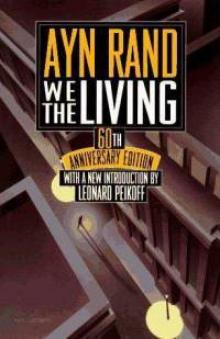 We the Living
We the Living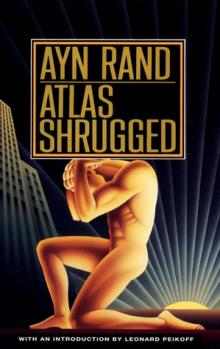 Atlas Shrugged
Atlas Shrugged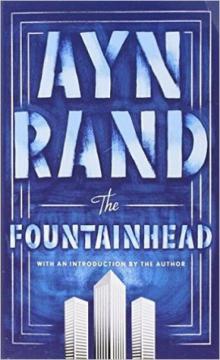 The Fountainhead
The Fountainhead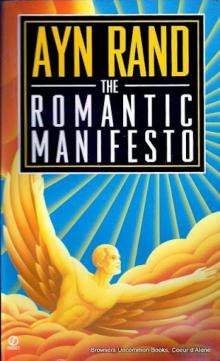 The Romantic Manifesto: A Philosophy of Literature
The Romantic Manifesto: A Philosophy of Literature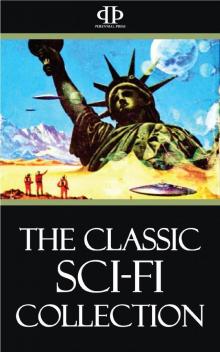 The Classic Sci-Fi Collection
The Classic Sci-Fi Collection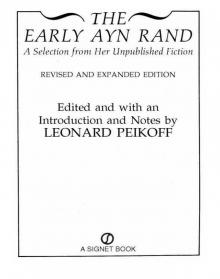 The Early Ayn Rand
The Early Ayn Rand